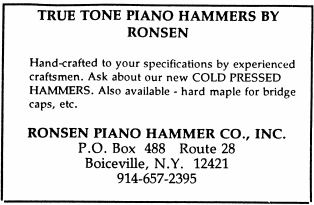|
by Marty Dinerstein - Secretary Our October meeting was scheduled for 7 PM on October 9th. Unfortunately our speaker, Steve Fairchild, injured himself shortly before the meeting and called to advise us that he could not come. In addition, many of our members were apparently unable to attend and we had only three members and one guest - Lee Dobrins. We made the most of our time by discussing various problems that we had in the field and Lee and I told the others about the NYSCON Convention which we had attended. We ended our impromptu discussion at 9:15.
by Paul Eccardt, Chapter President Have you ever seen vertical pianos with dampers that lift half way, and then you find you can't do a good job adjusting them because there is no pedal travel? Sometimes this is due to a cracked bottom board. If you are in your customer's home, this repair is easier if you put the piano on its side instead of its back. It takes less space and it is easier to lift. If you carry a screw gun in your car, you'll find it handy for removing the large number of screws that hold the bottom board on. When you get it off, use C.A. glue and clamp it. Make sure you put rags or newspaper down underneath it so the glue doesn't hit the floor. This is also an excellent time to inspect, tighten, and oil the castors on the piano. When you put the bottom board back, you can use the screw gun, but don't put them all the way in, because you might strip the screws - finish tightening them by hand.
|
by Michael Slavin, RPT
When replacing missing lyre braces on a grand piano with wooden dowels, it is very useful to adapt the configuration found on newer Baldwin pianos - that is, a capstan screw on the keybed end of the dowel. Cut the dowel a bit shorter than the actual length required (about ½"), carefully center and drill a pilot hole in one end of the dowel, and thread in a grand capstan screw. A precise cut of the dowel is now much less critical for a secure fit, as the capstan can be adjusted for the desired tightness and modified for seasonal variations if necessary.
|

